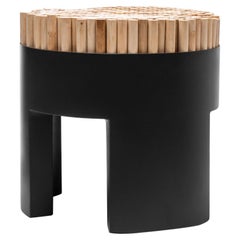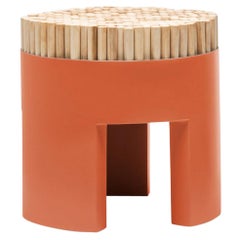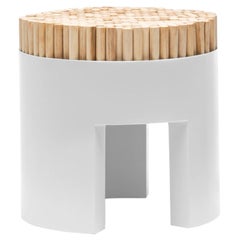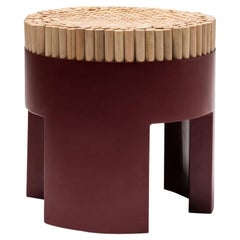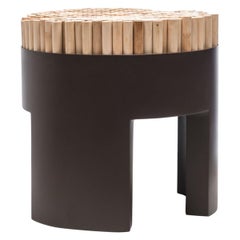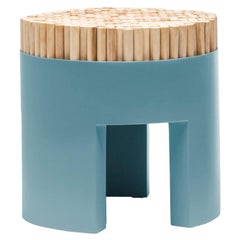Chiquita Stool
Black Chiquita Stool by Kenneth Cobonpue
By Kenneth Cobonpue
Located in Geneve, CH
Chiquita black stool by Kenneth Cobonpue
Materials: Rattan, Polyurethane foam, steel.
Dimensions
Category
2010s Philippine Modern Stools
Materials
Steel
Tangerine Chiquita Stool by Kenneth Cobonpue
By Kenneth Cobonpue
Located in Geneve, CH
Chiquita Tangerine stool by Kenneth Cobonpue
Materials: Rattan, polyurethane foam, steel
Category
2010s Philippine Modern Stools
Materials
Steel
Silver Chiquita Stool by Kenneth Cobonpue
By Kenneth Cobonpue
Located in Geneve, CH
Chiquita silver stool by Kenneth Cobonpue.
Materials: Rattan, polyurethane foam, steel
Category
2010s Philippine Modern Stools
Materials
Steel
Red Chiquita Stool by Kenneth Cobonpue
By Kenneth Cobonpue
Located in Geneve, CH
Chiquita red stool by Kenneth Cobonpue.
Materials: Rattan, Polyurethane foam, steel.
Dimensions
Category
2010s Philippine Modern Stools
Materials
Steel
Chocolate Brown Chiquita Stool by Kenneth Cobonpue
By Kenneth Cobonpue
Located in Geneve, CH
Chiquita chocolate brown stool by Kenneth Cobonpue.
Materials: Rattan, Polyurethane foam, steel
Category
2010s Philippine Modern Stools
Materials
Steel
Sky Blue Chiquita Stool by Kenneth Cobonpue
By Kenneth Cobonpue
Located in Geneve, CH
Chiquita sky blue stool by Kenneth Cobonpue
Materials: Rattan, Polyurethane foam, steel
Category
2010s Philippine Modern Stools
Materials
Steel
People Also Browsed
The Charles Dudouyt Coffee Table
Located in Banbury, GB
A fine carved and turned oak small circular table in the manner of Charles Dudouyt. The incised oak top on spinal corkscrew design column on triple ball feet. Polished lightly aged o...
Category
21st Century and Contemporary Coffee and Cocktail Tables
Materials
Oak
Maharam Pillow, Point by Paul Smith
By Paul Smith, Maharam
Located in New York, NY
Maharam Pillow
Point by Paul Smith
014 Citrus
A study in variegation, Point by Paul Smith explores scale, density, rhythm, color, and proportion in an imaginative display of Britis...
Category
21st Century and Contemporary American Modern Pillows and Throws
Materials
Nylon
HARPER Wall Light or Sconce in Blown Glass & Brass, Blueprint Lighting 2021
By Fontana Arte, Blueprint Lighting
Located in New York, NY
Introducing Harper, the new wall lamp design by Blueprint Lighting.
Named for Ace Harper; artist, musician, fashion designer, mother and wife of iconic rock drummer Matt Sorum. F...
Category
2010s American Modern Wall Lights and Sconces
Materials
Brass, Bronze, Nickel
$2,900 / item
H 39 in W 8 in D 7 in
French Pair of Nightstands Side Cabinets Bedside Tables Brutalist Style, 2022
Located in Labrit, Landes
Pair of oak nightstands "Pyrénées" signed by Sébastien Lamarre.
This french side cabinets were made by Sébastien Lamarre for Maison Marie Anne.
The creator chose for the Pyrénées mo...
Category
21st Century and Contemporary French Brutalist Night Stands
Materials
Oak
$2,120 / set
H 24.81 in W 23.63 in D 13.78 in
Phillip Walnut Nightstand and Side Table
By Crump and Kwash
Located in Baltimore City, MD
Phillip Nightstand
by Crump and Kwash
Solid wood case with continuous waterfall grain / blackened steel pulls and base / hand shaped walnut feet / natural oil finish.
Wood Option...
Category
2010s American Modern Night Stands
Materials
Steel
Set of Mae Solid Wood Nightstands / End Tables with Leather Shelf
By Crump and Kwash
Located in Baltimore City, MD
Mae nightstands with shelf by Crump and Kwash
This listing is for a pair of new nightstands.
Features
Solid wood frame / hand turned legs / hand rubbed oil finish / solid brass p...
Category
2010s American Modern Night Stands
Materials
Brass
$9,650 / set
H 29.5 in W 36 in D 23 in
Handmade Wicker Ceiling Lamp with Wavy Shapes
Located in Marbella, ES
Lámpara de techo de mimbre con formas onduladas, hecha a mano
Category
2010s Chandeliers and Pendants
Materials
Wicker
Danish Modern, Pair of Highback Lounge Chairs in Style of Henning Kjærnulf, 1960
By Henning Kjærnulf
Located in Odense, DK
A sculptural pair of comfortable highback lounge chairs crafted from high-quality materials, their style is reminiscent of the work of Danish designer Henning Kjærnulf. Armrest carve...
Category
Mid-20th Century Danish Mid-Century Modern Lounge Chairs
Materials
Fabric, Oak, Velvet
$4,800 / set
H 39.77 in W 31.89 in D 30.71 in
Formia 1990s Vintage Italian Green Murano Glass Cactus Plant with White Flower
By Formia Murano
Located in New York, NY
1990 Italian highly collectible glass cactus plant of limited edition, entirely handcrafted in Murano, signed Formia, with modern Minimalist design, in a lifelike organic Modernist s...
Category
1990s Italian Organic Modern Natural Specimens
Materials
Gold
$416 Sale Price
30% Off
H 7 in Dm 4.25 in
Mid-Century Modern Grand Pouf, DEDAR Pearl Bouclé, Handmade Portugal Greenapple
By Greenapple, GF Contemporary
Located in Lisboa, PT
Grand Pouf, Modern Collection, Handcrafted in Portugal - Europe by GF Modern.
The Grand pouf is a versatile piece that combines elegance with functionality. Its curved, sculptural d...
Category
21st Century and Contemporary Portuguese Mid-Century Modern Ottomans and...
Materials
Stainless Steel, Brass
$2,144 / item
H 23.63 in W 21.66 in D 19.69 in
Ceramic Link Chain Wall Sculpture
By Asmaa Aman-Tran
Located in Attleboro, MA
Chains echo different emotions in us, some see them as a symbol of imprisonment, and vulnerability and some see as an emotion of inter connectivity and strong bond between the people...
Category
2010s American Organic Modern Decorative Art
Materials
Ceramic, Stoneware, Linen
Dining Chairs by Henning Kjærnulf, Model Razoblade, Denmark, Oak
By Henning Kjærnulf
Located in Esbjerg, DK
Set of striking dining chairs by Henning Kjærnulf, made of oak and honey coloured lambskin.
Refreshing design with bold Baroque coming together nicely with Mid-Century Modernism.
M...
Category
2010s Danish Scandinavian Modern Dining Room Chairs
Materials
Oak
$810 Sale Price / item
47% Off
H 33.47 in W 19.69 in D 19.69 in
Dining Chairs by Henning Kjærnulf, Model Razorblade, Denmark, Oak
By Henning Kjærnulf
Located in Esbjerg, DK
Set of striking dining chairs by Henning Kjærnulf, made of oak and boucle.
Refreshing design with bold Baroque coming together nicely with Mid-Century Modernism.
Model: Razorblade
...
Category
2010s Danish Scandinavian Modern Dining Room Chairs
Materials
Oak
$667 Sale Price / item
55% Off
H 33.47 in W 19.69 in D 19.69 in
Rare Wave-Pattern Upholstery, Swivel Lounge Chair, Manner of Milo Baughman
By Milo Baughman
Located in Saint Petersburg, FL
Wave-pattern upholstery highlights a curvaceous & sculptural form. Wood pedestal base, with a 360 degree swivel mechanism. Chair maintains it's good structure. Extremely comfortable!
Category
20th Century American Mid-Century Modern Club Chairs
Materials
Velvet, Wood
$3,150
H 31.5 in W 33 in D 32 in
Majestic Mid century Modern Floor Lamp
By Majestic Lamp Company
Located in Weesp, NL
"Atomic" floor lamp manufactured in the 1950s, by the Majestic Lamp Co. of NYC.
The lamp has a three way switch, first click turns on the bottom bulb, second click turns on the top b...
Category
Vintage 1950s American Mid-Century Modern Floor Lamps
Materials
Brass
Ribera Handmade Large Centerpiece Bowl - Stoneware
By OWO Ceramics
Located in Ciudad Autónoma de Buenos Aires, AR
Beautiful large centerpiece bowl crafted from stoneware clay. Inspired by the vibrant marine life of the reef and the soft motion of ocean waves, this extra large fruit bowl showcase...
Category
2010s Argentine Modern Centerpieces
Materials
Ceramic, Clay, Pottery, Stoneware
Get Updated with New Arrivals
Save "Chiquita Stool", and we’ll notify you when there are new listings in this category.
More Ways To Browse
Royal Albert Lady Hamilton
Royal Vienna Cup
Royal Worcester Ewer
Royal Worcester Porcelain Birds
Rubens Ceramics
Ruby Red Ashtrays
Running Rabbit
Russian Bear Bronze
Russian Lacquer Box Fairy Tale
Russian Niello Snuff Box
Russian Porcelain Easter Egg
Russian Teapot
Ruth Mayer
Ruth Milles
Rye Pottery
Ryozan Satsuma
S Bent Bros
Saca Ceramic
